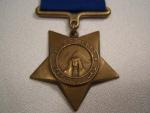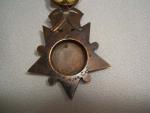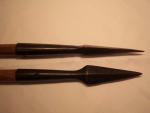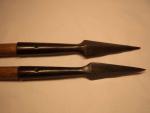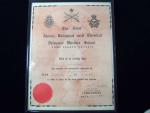-
Posts
6,486 -
Joined
-
Last visited
-
Days Won
10
Content Type
Profiles
Forums
Blogs
Gallery
Events
Store
Everything posted by Brian Wolfe
-

My Khedive's Star Collection
Brian Wolfe replied to Brian Wolfe's topic in Great Britain: Orders, Gallantry, Campaign Medals
Hello Everyone, I've managed to add a named Khedive's Star 1882 to my collection and am quite happy to have done so, after many years without one. The obverse: As may be seen in the photo the original hanger is missing and has been replaced with one that is quite plane. It is an old replacement and looks to have been made for just such a medal. Does anyone have any knowledge of this style of hanger. Is it a replacement to make mounting easier or simply a matter of a replacement for a damaged original? The reverse will be shown in the next photo. Regards Brian -
Welcome SCcollector, That's a great addition to the thread. When I started this thread I thought I would be posting material and information purely for myself, never dreaming that there were so many others with like interests. Thanks for helping to keep this thread alive and well. I look forward to seeing more of your submissions. Regards Brian
-
Here is a view of the reverse. This medal was awarded to: SOWAR FUZL DAD, 3rd PUNJAB CAVY. I find it interesting in the way they have strengthened the medal where the crown meets the Star. It's a good thing too as I would think very few would have survived these many years had they not taken these steps. Regads Brian
-
The subject of my post is the Kabul to Kandahar Star 1880 which now resides in my collection. To begin here is a little background to the Battle of Kandahar. 1. The Siege of Kandahar. After the death of the Afghan ruler in May 1879, Amir Sher Ali Khan's son and successor, Mohammad Yaqub Khan, signed a treaty with the British, part of which agreed to allow a British resident at Kabul. On 3 September the British representative in Residence, Sir Pierre Louis Napoleon Cavagnari and the other members of the mission were massacred by Afghan troops. Yaqub Kahn was removed from power by the British and exciled due to suspicions that he had a part in the massacre. During this time it was decided to withdraw all British troops from Afghanistan, however before this could take place, Yaqub Khan's brother, Ayub Khan stirred up anti-British sentiments and moved out of Herat where he was the Governor with 10,000 followers. A force of 1,500 British and Indian troops was dispatched to intercept his force. The British commander, Brigadier George Burrows, clashed with Ayub Khan on 27 July 1880 at Maiwand. The British/Indian force was defeated and the survivors marched 45 miles to the city of Kandahar were they fortified the city and awaited the arrival of the Afghan force under Ayub Khan. Of the 1,500 British/Indian forces that met Ayub Khan in the battle at Maiwand only 540 had survived to reach Kandahar. These troops, plus the garrison at Kandahar, brought the fighting strength of the city to 4,360. The population was evacuated and the city fortified for the upcoming siege. On 8 August Ayub Khan besieged the city with his forces including artillery pieces which started firing on the British/Indian forces from surrounding villages situated on higher ground. 2. The relief Force. A relief force of 10,000 was sent from the garrison at Kabul under the command of General Roberts, who personally lead the division. The march was a grueling 320 miles but would take only 20 days to complete. Due to the need for speed the force travelled light carrying only 20-30 lbs. of kit per trooper. In addition to this no artillery or wheeled transport was taken along which would have only served to slow the pace. The relief force arrived at Kandahar on 31 August 1880. However, possibly fearing he would be caught between th city's force and the relief column Ayub Khan lifted his siege and moves his forces to the village of Mazra in the Urgundab valley. The attack on Ayub Khan came on 1 September 1880. The Afghan force was defeated after heavy fighting and Auyb Khan was forced to abandon his camp at Mazra. 3. The 3rd Punjab Cavalary The plan was for General Hugh Henry Gough to intercept the retreating Afghans with his cavalry which included the 417 members of the 3rd Punjab Cavalry, commanded by Lt. Colonel A. Vivian. The 3rd Punjab Cavalry pursued Ayub Kahn's forces toward Khakrez. A small remnant of the Afghan Army along with Ayub Khan escaped and became fugitives, later to raise another army and lead a revolt against the new British appointee to the position of power, Abdur Rahman. This new revolt was quickly put down ending in the death of Ayub Khan. This brought to a close the Second Anglo-Afghan War and relative peace endured until the Third Anglo-Afghan War of 1919 broke out. The 3rd Punjab Cavalry were later involved in the expidetion against the MArris tribe of the North West Frontier and then returned to India. You should research further into the interesting history of the actual battle but since my post is to deal with the medal shown below I have condensed the conflict's history drastically. An interesting point about the Kabul to Kandahar Stars is that the bronze they were struck from came from Ayub Khan's guns that were captured at the battle of Kandahar, which was actually at Mazara. Regards Brian
-
This is a view of both profiles. Since they are almost identical the photo is a good representation of both lance heads. The bronze is blackend as shown in the photo. The whole photo has a gold hew due to the lighting.
-
Hello everyone, Many years ago I purchased one of these lance point at a gun show then nearly a year later I purchased another from a junk dealer at what was misleadingly advertised as an Antiques Show. The two were purched here in Ontario, one near Hamilton the other in London, Ontario. They are not exactly the same though close enough that I believe them to have shared the same manufacturer. The longest one is 10 inches and the shorter being 9 3/4 inches. The blade measured from the intersecting planes, on the blade above the socket, is 1 1/2 inches wide with one being 4 3/4 inches and the shorter being 4 1/4. The difference in the length between the two being mostly in the blade. The socket takes a 7/8 inch tapered shaft and as may be seen in the photos I had to take the 1 inch dowel down a bit in order to fit the socket. They are held onto the wooden shaft by means of two screws, one above the other so that the screws do not meet. The position of the holes is identical in both sockets. No markings can be found on the lance heads. I've been looking at every lance tip I can find in books, on the internet and in museums but have never found their like. They do not appear to be flag staff tips and are quite ruggedly made. Any suggestions as to their identification is most appreciated. I've had these for probably 40 years...oh, how time passes so quickly. Thanks for any help you might be able to extend to me. Regards Brian
-

ANTEDELUVIAN BUFFALOES
Brian Wolfe replied to Mervyn Mitton's topic in Coins & Commemorative Medallions
I'm sure there is a market for them, somewhere. It's not like they are junk and as you said "- a lot of work in them". Anyone wanting a good "starter" collection of such memorabilia should jump at the chance to own them. Regards Brian -

Royal Marines Trio
Brian Wolfe replied to Chris Boonzaier's topic in Great Britain: Orders, Gallantry, Campaign Medals
Congratulations on a very nice addition to your collection. Regards Brian -
From what I've read about this final battle Wittman, who was noted as being bold, was getting careless possibly due to the pressures of being in combat too long. I don't mean any slight by the term "carless" and perhaps war-weary or "battle fatigue" would be better choices. Statistically a King Tiger could have withstood a hit much better than the Panzer VI Tiger he was in command of during this encounter. If the Canadains were using the 17 pounder of a Sherman Firefly would it have necessarily made a difference had the shot been in the most vulnerable area of the King Tiger, wherever that may be? I guess that's a question for debate and I don't have the answer. If Wittman, the so-called Black Barron, was showing signs of battle fatigue (it happened to the Red Barron in WWI) then had he survived this encounter would he have only fallen prey to another gunner later on? The Canadians were well hidden and German attention seems to have been on the British tanks in another direction, this gave the Canadians an advantage. An interesting debate and one I hope others will join in to voice their views and opinions. This encounter may have gone down as just another of many tank battles had the tables not turned in favour of the allies. So would this have changed history? No, just the outcome of this particular duel. Perhaps if he had been in a King Tiger this battle might never have made the history books at all. Also would the King Tiger have only served to make Wittman even bolder and prone to taking even more risk? Regards Brian
-

ANTEDELUVIAN BUFFALOES
Brian Wolfe replied to Mervyn Mitton's topic in Coins & Commemorative Medallions
Mike: Well done on the Flintstone trivia. We'll have to keep you in mind as our expert on everything regarding the Loyal Order of Water Buffaloes, if it comes up again. Mervyn: Sorry but I had to jump on this quickly as that was one of the few Latin terms I remembered from school, and one gets to use it so little these days. As we used to say, "Latin is all Greek to me". Ok, I failed humour as well. Regards Brian -
I've seen such items but nothing of this age, a very impressive and interesting piece of equipment. Periscopes were also fastened to a framework along with a rifle for snipers during WWI. There are lots of photos showing this on the internet so no need for me to photograph one from a book now. Regards Brian
-

My first QSA - 4 clasps
Brian Wolfe replied to Noor's topic in Great Britain: Orders, Gallantry, Campaign Medals
Cogratualtions on a fine QSA. Common clasps on a QSA (?), regardless of that this is a great medal. As time goes on the prices on what has been considered as common goes up making it harder and harder to find anything over two clasps. Well done and thanks for sharing it. Regards Brian -

ANTEDELUVIAN BUFFALOES
Brian Wolfe replied to Mervyn Mitton's topic in Coins & Commemorative Medallions
Of course you are correct, Mike. The first time I ran into this term was when reading about the antebellum houses that were built before and survived the Civil War. I wonder if this lodge is like the Service Clubs here, such as the Lions Club etc. Or is it was more like the Independent Order of Foresters that is basically an insurance club. That is to say, it was started by people who formed a insurance company and then supscribers were called members. My father belonged to the Foresters for a number of years. Didn't Fred Flintstone belong to a branch of the "Buffalos"? Regards Brian -
Hi Neville, Welcome aboard! As Mervyn mentioned we seem to be drawing quite a few collectors from SA as of late. It's good to see new members from different parts of the world with different collecting "tastes". I'm looking forward to seeing your items posted on the GMIC, as I know many other members are as well. Regards Brian
-

A. Thompson Saddler
Brian Wolfe replied to Will M's topic in Great Britain: Mervyn Mitton's British & Colonial Police Forces
My thoughts on this item are that the stamp has nothing to do with either the recipient nor his occupation. A stamp would not have been produced to stamp an item that was a "one-off", that is to say for one recipient. As to the police service, it would be very hard to tell as most, if not all, police carried these or the weighted leather "sap" until the baton and then later the ASP were issued. My feeling is that this could very well have been either in someone's collection or was a memento of the officer's service or perhaps of the owner's father's service. I think the former to be most likely the case as if it belonged to the officer himself or his heir the plaque would have a name of the officer and not the manufacturer. A collector would be more apt to engrave the only information available to him (or her) on the plaque and in this case it was that of the manufacturer. Speaking as a woodworker I would say the board itself has the "look" of something produced in the shop of a hobbyist and not that of one that would be supplied by a trophy shop. While nice, it lacks that certain professional "look". A few years ago I was picking up some uniform items from a supplier (original shippment was short a few pieces of kit) and over in the corner there was a box with perhaps 50 or 60 wooden truncheons as well as the weighted leather saps. The price written on the side of the box was $2.00 each! I was in a hurry and didn't purchase any I've kicked myself ever since. I know this is has nothing to do with the topic but I've reached the age where I do prattle on once and a while. Regards Brian Regards Brian (See? I even repeat myself once and a while!) :lol: -
Hi Tomas, I love the hardware, thanks for posting it. Any plans to add the rest of the plane to your collection? Regards Brian
-
My biggest regret was selling off most of my collection thinking it would save my first marriage. Word to the wise guys, it will not make any differece...if she's walking she's walking. The collection was put together in the 1960's and 70's and consisted of Imperial German and TR medals and photos, British medals and decorations as well as edged weapons and firearms some of which were full autos, in working condition. I'll never see the likes of them again. Not to be sexist, the same advice goes for any of the ladies reading this. On the other hand if I took what I have now and added what I sold; where would I put everything? Regards Brian
-
Hello Everyone, Like many of the members my interests are, for the most part, in the area of the two world wars, especially WWI. So to bring my posts into a more current era here is a document from the Joint Atomic, Biological and Chemical Defensive Warfare School at Camp Borden, Ontario Canada. The document was awarded to WO2 JH Armstrong for completion of the WO & NCO Instructors NBCW Course and is dated 19 April 1962. The school still exisits and is now known as the Canadian Forces Nuclear, Biological and Chenical School (CFNBCS). CFNBCS is the national Centre of Excellence and primary souce for joint advanced individual training in the areas of Nuclear, Biological and Chemical Defence, Nuclear Emergency Response, Radiation Safety and Chemical, Biological, Radiological/Nuclear Counter Terrorism response. CFNBCS annually offers 9 different cources that provide these specialist-training oppertunities to over 600 personel per year. The mission of CFNBCS is to conduct training in accordance with approved doctrine and standards on Neclear, Biological and Chemical Defence, Radiation Safety and Nuclear Emergency Response; and carry out Nuclear Biological and Chemical Trials and Evaluations as directed. The vision of CFNBCS is to be the nationally accepted and respected Centre of Excellence and the primary source for exceptional advanced individual training in the areas of: . Nuclear, Biological and Chemical Defence . Nuclear Emergency Response; and . Radiation Safety. On July 5, 2004, the Canadian Forces Academy and the Canadian Forces Nuclear, Biological and Chemical School took the first preliminary step towards building a closer relationship. In keeping with the Canadain Forces Support Training Group vision of transforming its training delivery function to meet the training needs of the Army, Air Force and Navy, these two schools were merged under one command structure. Above material from National Defence http://www.borden.forces.gc.ca/998/9/60/997-63-eng.asp In the background of the diploma is an atomic blast mushroom-shaped cloud. I have not seen any modern examples of these diplomas but the bomb blast is sure in keeping with the Cold War ear and the fears attached to it. Regards Brian
-
That's great Doc, thanks I will keep you in mind for future needs. Brian
-
Hi Erik, Please excuse my ignorance about things German, but where would these have been hung? Were they for the crew members themselves or were they displayed in the mess? I been a guest at different Canadian Forces Officer's and Sergeant's messes over the years and saw plaques from different regiments displayed there and I am wondering if this was the same sort of tradition in this case. Regards Brian
-
Thanks for the additional information Erik. I don't speak or read French very well but I did understand the "statement" written on the poster and then assumed it to be a propaganda "warning" poster. The section at the bottom is actually easy to read even for an Anglophone such as me. My German is no better than my French, all the sadder for me being a Canadian with a partial Germanic background. Regards Brian



